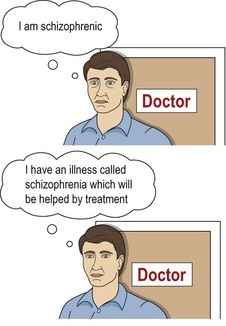Classification in psychiatry
The development of standardised methods of classifying psychiatric disorders has improved communication between clinicians and has made it possible to research the aetiology, management and prognosis of a particular diagnosis, thereby providing an empirical basis for clinical practice. As a result, diagnosis becomes a useful procedure rather than just a way of labelling people (Fig. 1).
Classification systems
There are two major classification systems used in psychiatry. The first is the International Classification of Disease, 10th version (ICD10), devised by the World Health Organization in 1993. The second classification system is the Diagnostic Systems Manual, currently in its 4th version (DSM IV), which has been produced by the American Psychiatric Association. The two systems are broadly similar and in this book we have mostly followed ICD10. Table 1 outlines the ICD10 classification of psychiatric disorders.
Table 1 Outline of ICD10 classification of psychiatric disorders
| Organic | Organic disorders: includes dementia, delirium, other organic disorders |
| Mental and behavioural disorders due to psychoactive substance use | |
| Functional | Schizophrenia, schizotypal and delusional disorders |
| Mood disorders: includes bipolar disorder, depressive illness, cyclothymia, dysthymia | |
| Neurotic, stress-related and somatoform disorders: includes anxiety disorders, obsessive-compulsive disorders, reactions to stress, dissociative and somatoform disorders | |
| Behavioural syndromes associated with physiological disturbances and physical factors: includes eating disorders, sleep disorders, sexual dysfunction | |
| Disorders of adult personality and behaviour: includes personality disorders, factitious disorders | |
| Mental retardation | |
| Disorders of psychological development | |
| Behavioural and emotional disorders with onset usually occurring in childhood and adolescence | |
| Unspecified mental disorder |
Stay updated, free articles. Join our Telegram channel

Full access? Get Clinical Tree



